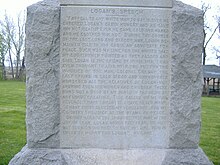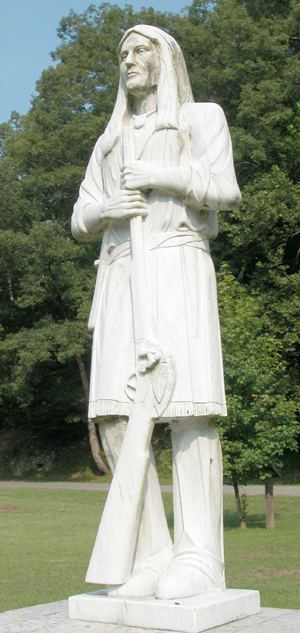
Logan the Orator was a Cayuga orator and war leader born of one of the Six Nations of the Haudenosaunee Confederacy. After his 1760s move to the Ohio Country, he became affiliated with the Mingo, a tribe formed from Seneca, Cayuga, Lenape and other remnant peoples. He took revenge for family members killed by Virginian Long knives in 1774 in what is known as the Yellow Creek Massacre. His actions against settlers on the frontier helped spark Dunmore's War later that year.

The Shawnee are a Native American people of the Northeastern Woodlands. Their language, Shawnee, is an Algonquian language.

Lord Dunmore's War, also known as Dunmore's War, was a brief conflict in fall 1774 between the British Colony of Virginia and the Shawnee and Mingo in the trans-Appalachian region of the colony south of the Ohio River. Broadly, the war included events between May and October 1774. The governor of Virginia during the conflict was John Murray, 4th Earl of Dunmore, who in May 1774, asked the House of Burgesses to declare a state of war with the Indians and call out the Virginia militia.
John Gibson was a veteran of the French and Indian War, Lord Dunmore's War, the American Revolutionary War, Tecumseh's War, and the War of 1812. A delegate to the first Pennsylvania constitutional convention in 1790, and a merchant, he earned a reputation as a frontier leader and had good relations with many Native American in the region. At age sixty he was appointed the Secretary of the Indiana Territory where he was responsible for organising the territorial government. He served twice as acting governor of the territory, including a one-year period during the War of 1812 in which he mobilized and led the territorial militia to relieve besieged Fort Harrison.

The Battle of Point Pleasant, also known as the Battle of Kanawha and the Battle of Great Kanawha, was the only major action of Dunmore's War. It was fought on October 10, 1774, between the Virginia militia and Shawnee and Mingo warriors. Along the Ohio River near modern-day Point Pleasant, West Virginia, forces under the Shawnee chief Cornstalk attacked Virginia militiamen under Colonel Andrew Lewis, hoping to halt Lewis's advance into the Ohio Valley. After a long and furious battle, Cornstalk retreated. After the battle, the Virginians, along with a second force led by Lord Dunmore, the Royal Governor of Virginia, marched into the Ohio Valley and compelled Cornstalk to agree to a treaty, which ended the war.

Cornstalk was a Shawnee leader in the Ohio Country in the 1760s and 1770s. His name in the Shawnee language was Hokoleskwa. Little is known about his early life. He may have been born in the Province of Pennsylvania. In 1763, he reportedly led a raid against British American colonists in Pontiac's War. He first appears in historical documents in 1764, when he was one of the hostages surrendered to the British as part of the peace negotiations ending Pontiac's War.
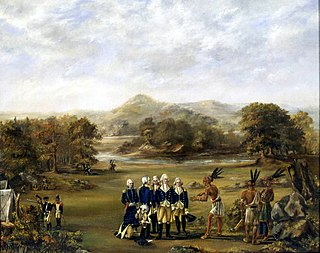
The Northwest Indian War (1785–1795), also known by other names, was an armed conflict for control of the Northwest Territory fought between the United States and a united group of Native American nations known today as the Northwestern Confederacy. The United States Army considers it the first of the American Indian Wars.

The western theater of the American Revolutionary War (1775–1783) was the area of conflict west of the Appalachian Mountains, the region which became the Northwest Territory of the United States as well as what would become the states of Arkansas, Kentucky, Louisiana, Missouri, and Tennessee. The western war was fought between American Indians with their British allies in Detroit, and American settlers south and east of the Ohio River, and also the Spanish as allies of the latter.
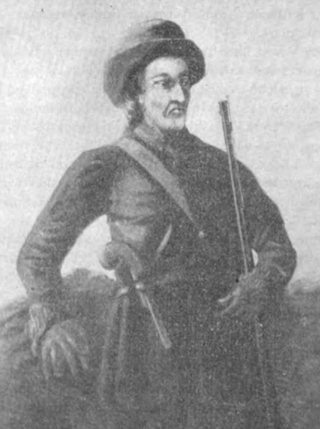
Simon Girty also known by his Seneca Nation name, Katepacomen, or "Renegade Girty" was a Pennsylvania-born loyalist and white chief of several tribes within the Shawnee-Iroquoian nations between the period of 1777 - 1812, and slave owner. Girty is most well known for overseeing the brutal torture and murder of Col William Crawford in 1782, and serving as the chief of a Miami tribe whose band of 400 warriors killed Major James Fontaine, the son of General Charles Scott during General Josiah Harmar's campaign.
Daniel Greathouse was a settler in colonial Virginia. His role in the Yellow Creek massacre in 1774 was instrumental in starting Lord Dunmore's War.

Michael Cresap was a noted frontiersman born in Maryland, in what is now the United States.
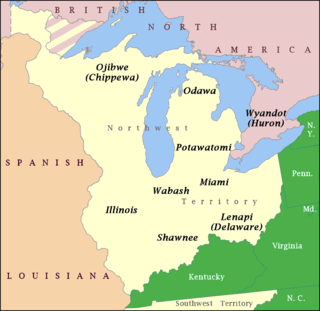
The Northwestern Confederacy, or Northwestern Indian Confederacy, was a loose confederacy of Native Americans in the Great Lakes region of the United States created after the American Revolutionary War. Formally, the confederacy referred to itself as the United Indian Nations, at their Confederate Council. It was known infrequently as the Miami Confederacy since many contemporaneous federal officials overestimated the influence and numerical strength of the Miami tribes based on the size of their principal city, Kekionga.
Colonel Thomas Cresap (c.1702—c.1790) was an English-born settler and trader in the states of Maryland and Pennsylvania. Cresap served Lord Baltimore as an agent in the Maryland–Pennsylvania boundary dispute that became known as Cresap's War. Later, together with the Native American chief Nemacolin, Cresap improved a Native American path to the Ohio Valley, and ultimately settled and became a large landowner near Cumberland, Maryland, where he was involved in further disputes near Brownsville, Pennsylvania, including in the French and Indian War and Lord Dunmore's War.
Snake was the English language name of two Shawnee leaders prominent in the history of the Ohio Country: Peteusha and Shemanetoo. They were both commonly referred to as "Snake" in historical records, or by variations such as "Black Snake" or "Captain Snake," so it is often difficult to determine which individual was being referred to. On a number of occasions, the two Snakes both signed a letter or appeared together, so it is clear they were two different people. There may have been additional Shawnees called "Snake," further complicating the matter. According to historian John Sugden, "it is unlikely if the biographies of these chiefs will ever be completely disentangled."

The Mingo people are an Iroquoian group of Native Americans, primarily Seneca and Cayuga, who migrated west from New York to the Ohio Country in the mid-18th century, and their descendants. Some Susquehannock survivors also joined them, and assimilated. Anglo-Americans called these migrants mingos, a corruption of mingwe, an Eastern Algonquian name for Iroquoian-language groups in general. The Mingo have also been called "Ohio Iroquois" and "Ohio Seneca".

Angus McDonald was a prominent Scottish American military officer, frontiersman, sheriff and landowner in Virginia.

David Glenn was of Irish descent and was born in 1753, likely in Pennsylvania but possibly in Virginia. He was one of the early settlers of Kentucky having accompanied James Harrod in founding Harrodstown in 1774, along with his older brother, Thomas. Today, Harrodsburg is considered the oldest permanent white settlement in Kentucky, being it was settled almost a full year before Boonesborough.
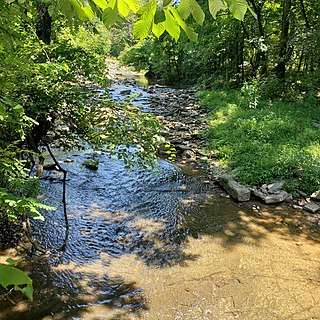
Thomas Glenn was among the first pioneers to venture into the Western Virginia and Kentucky territories. He was born in 1750 in present-day Pennsylvania, married before 1770 and settled in present-day Wheeling, West Virginia by 1774, but possibly earlier. He was part of an advanced detachment of John Floyd's survey expedition before joining James Harrod's party in founding Harrodstown, the earliest permanent white settlement west of the Appalachians, along with his younger brother David Glenn. Together they explored a large portion of Kentucky in the 1770s making several improvements from Frankfort down to Russell Springs.
Kekewepelethy, also known as Captain Johnny, was the principal civil chief of the Shawnees in the Ohio Country during the Northwest Indian War (1786–1795). He first came to prominence during the American Revolutionary War (1775–1783), in which he, like most of his fellow Mekoche Shawnees, initially sought to remain neutral. He joined the war against the United States around 1780, moving to Wakatomika, a Shawnee town known for its militant defense of the Ohio Country.

Logan's War was a 1774 retribution campaign or "mourning war" led by Mingo leader Logan in retaliation for the Yellow Creek massacre. Lord Dunmore's War was a direct result of Logan's campaign.

